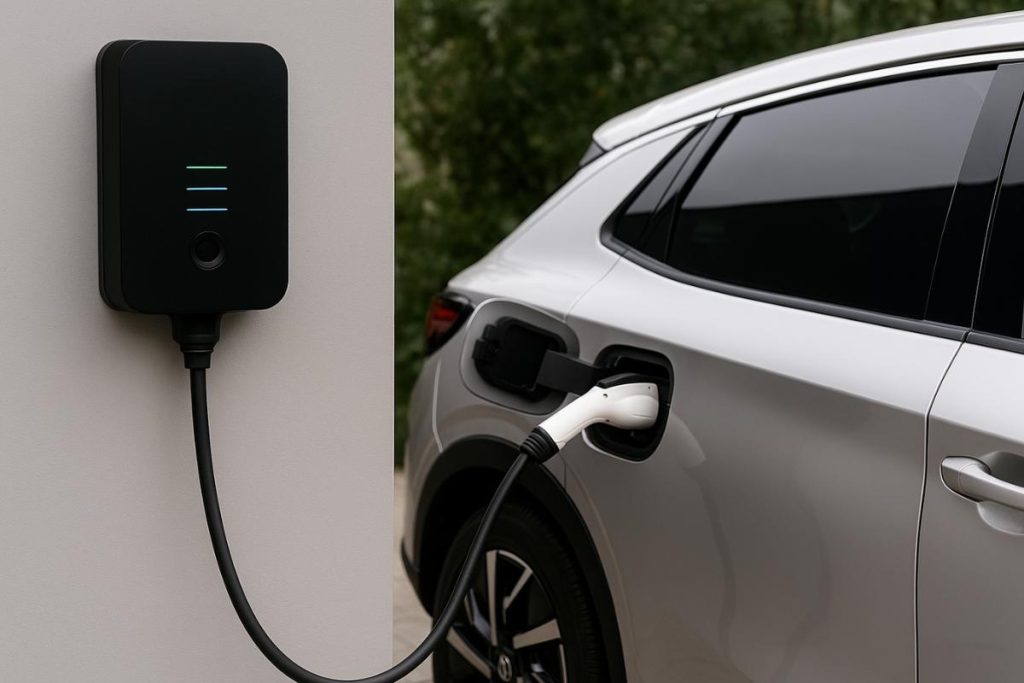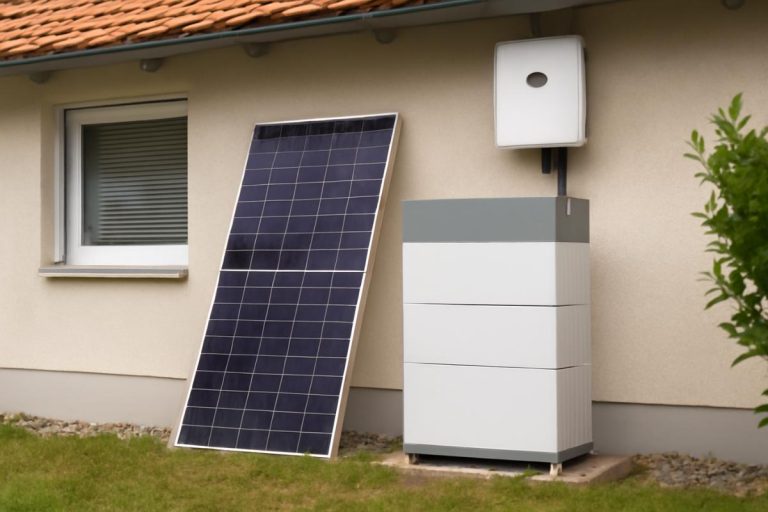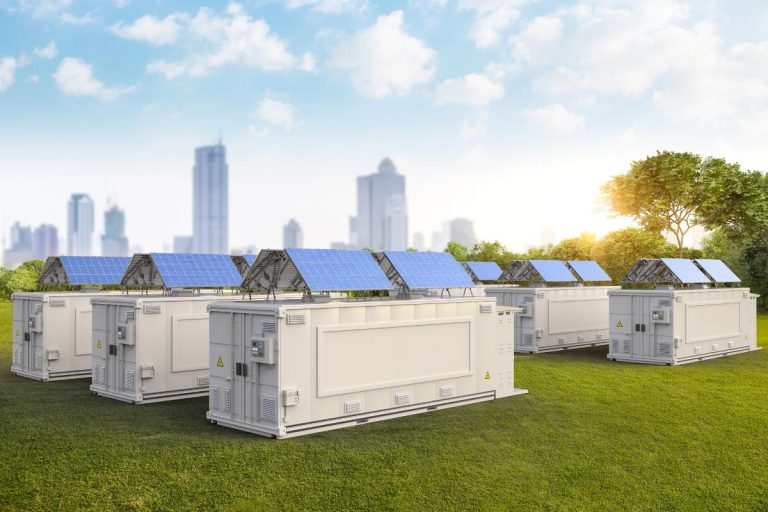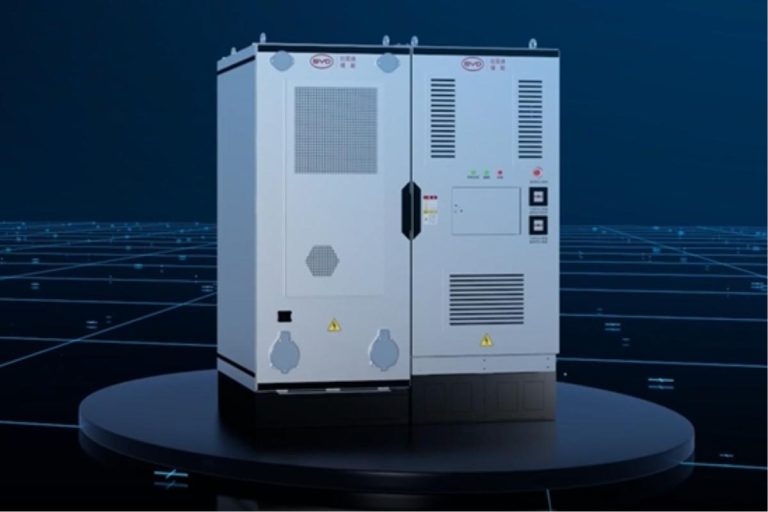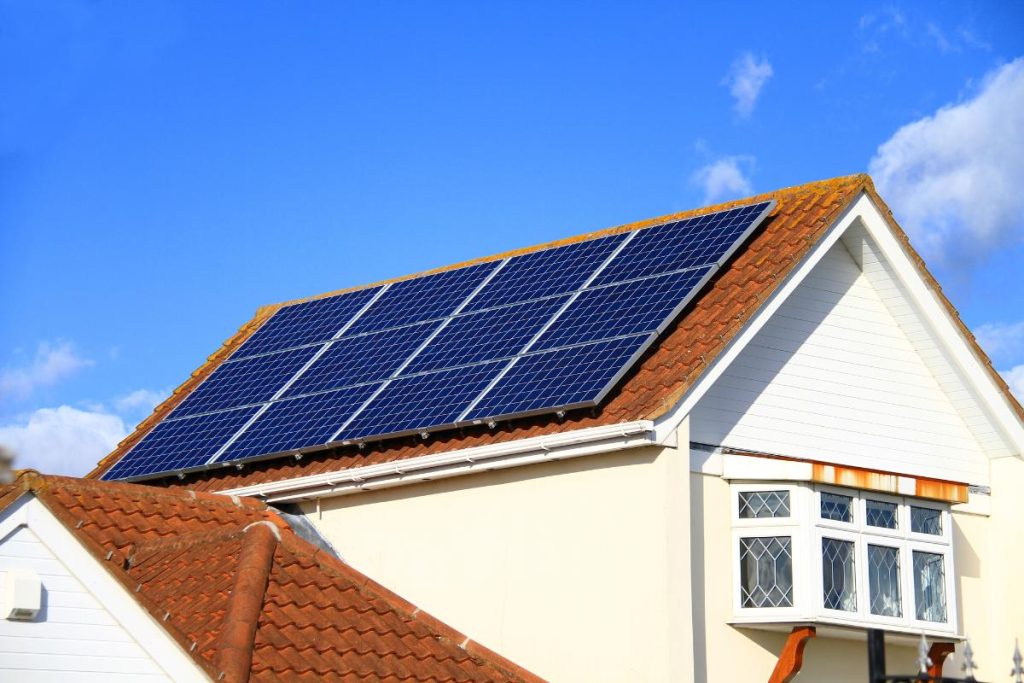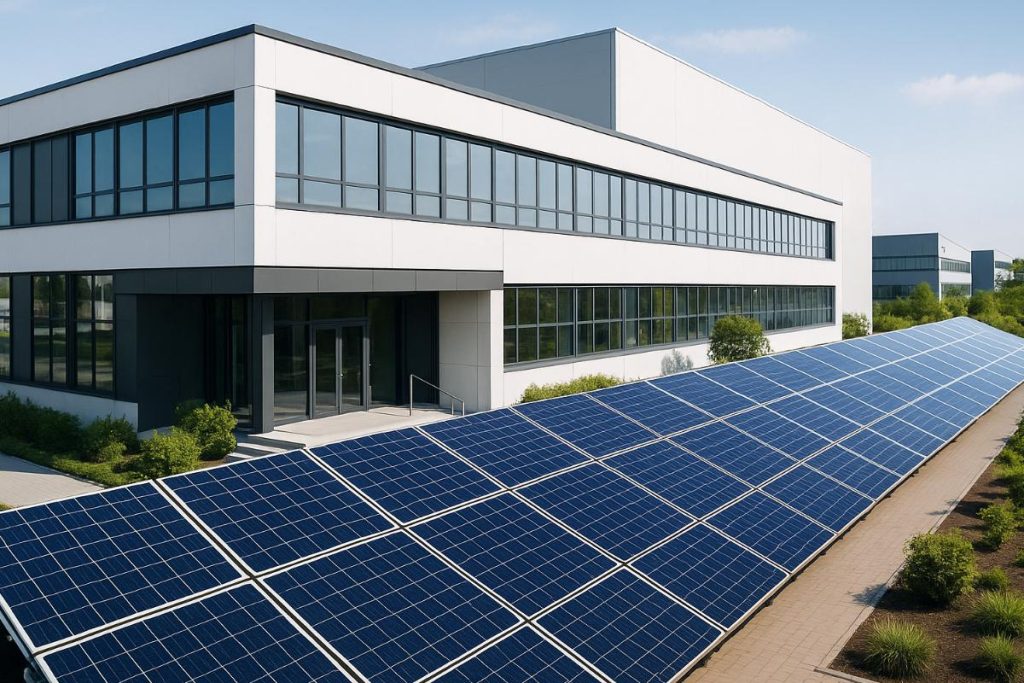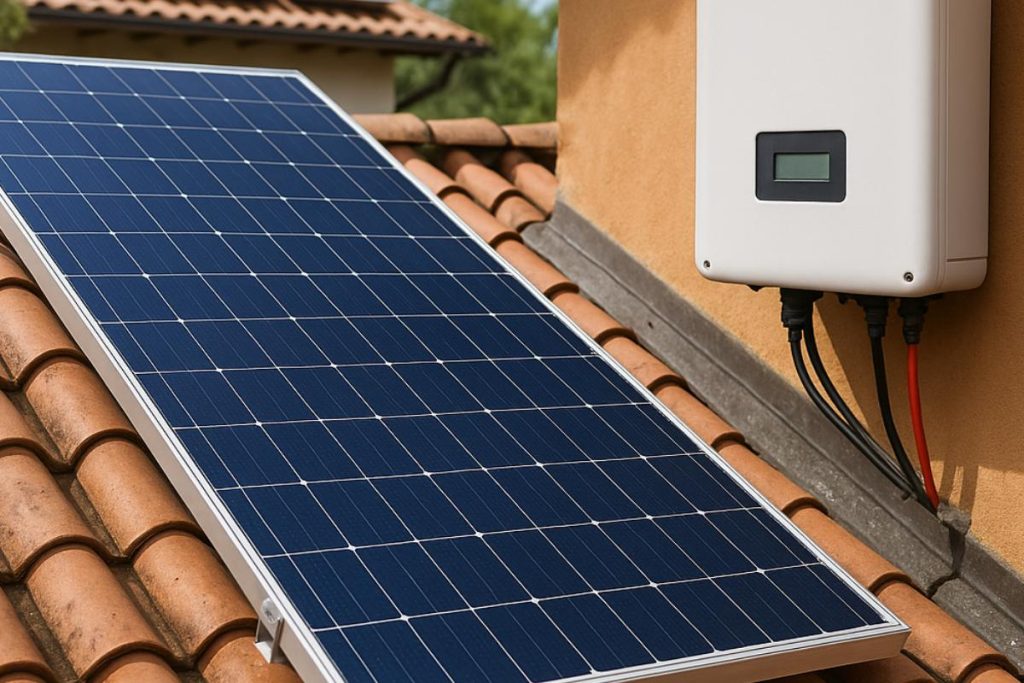With the popularization of electric vehicles, knowing how to charge an electric car at home or on the road has become essential. Unlike filling up with fuel, recharging an electric vehicle involves connect it to a power source through an appropriate piece of equipment called electric car charger.
But what types of chargers are available and how do they work? In this comprehensive guide, we'll explain everything about vehicle chargers, from the portable and residential models (wallbox) to the fast and ultra-fast chargers found in public stations. You will also see how to safely install an electric charger at home, the costs involved and tips for optimizing the recharging of your EV (Electric Vehicle).
To put this into context, the charging infrastructure is growing rapidly along with the electric fleet in Brazil. Currently, the country has around 4,600 public charging points (electro-posts) and the forecast of the Brazilian Electric Vehicle Association (ABVE) is to achieve 10,000 electro-posts by the end of 2025. Major partnerships are driving this expansion, for example, in 2024 BYD signed an agreement with Raízen to install 600 charging stations of electric vehicles in eight Brazilian capitals. In other words, charging an electric car is becoming increasingly easy and affordable.
In this article, you'll discover which type of electric vehicle charger is best suited to your needsand understand the differences in speed (power), connection and cost of each model. We'll also show you a step-by-step summary of residential installation and answers to frequently asked questions (FAQ) at the end. By the end of the book, you'll be well-informed to choosing the right charging solution and make the most of electric mobility.
What is an electric car charger and how does it work?
One electric car charger is nothing more than the equipment used to recharging the battery of an electric or plug-in hybrid vehicle in a safe and controlled manner. It acts as an intermediary between the power grid and the vehicle, ensuring that power is transmitted at the right voltage and current. It is worth noting that all electric cars have an "internal charger"This is the device inside the car responsible for converting alternating current (AC) from the mains into direct current (DC) for storage in the battery. So, when we talk about external chargers (such as the wallbox or the laptop), they actually work by supplying AC power in a safe way so that the internal vehicle charger convert to DC and charge the battery.
In the case of direct current (DC) fast chargersThe AC-DC conversion is carried out by the external equipment itself. These ultra-fast DC chargers provide power directly in direct current to the car battery, bypassing the vehicle's internal charger. This allows for much higher power outputs and much shorter charging times, but requires robust and more expensive equipment, normally used in commercial applications.
In short, the charger (be it a portable cable, wallbox or quick station) establishes communication with the vehicle and controls the flow of electricity during recharging. It checks safety parameters before releasing the current, for example, that the connector is properly seated and that there are no faults. During charging, the system monitors temperature, voltage and current, avoiding overloads or short circuits. In the end, the car itself or the charger automatically stops the flow of energy when the battery reaches 100% or according to the configured limits.
Why not just use the standard socket? Many people ask if it is possible to charging an electric car from a household socket. In fact, it is possible to connect the vehicle directly to an ordinary socketand even most electric cars already come with a portable emergency charger which allows this connection. However, charging daily from a simple household socket not recommended. Conventional sockets (127V or 220V, 10A or 20A) deliver limited power and can take 20, 30 or even 40 hours for a full loaddepending on the car battery. What's more, an ordinary socket can overheat or present risks if used continuously under high load. Therefore, to regular and faster useThe ideal is to have a dedicated chargerknown as wallboxThe system is equipped with an exclusive electrical circuit and adequate protection.
Below we'll look at the different types of chargers available and their characteristics.
Types of electric car chargers
Electric vehicle chargers are classified according to their charging power, place of use and charging speed. In general, we can separate them into three main levels:
- Level 1 (slow)Basic household use in ordinary sockets, low power (up to ~3.7 kW), supplied by portable chargers. More slowIt can take more than 24 hours to fully charge.
- Level 2 (semi-fast): Residential or commercial use with wallbox or dedicated AC stations, medium power (from ~7 kW to 22 kW). Charges in a few hours (typically 4 to 8 hours for a full battery, depending on the car).
- Level 3 (fast/ultrafast)Public use in high-powered electroplates (50 kW, 100 kW, up to 350 kW in some cases), generally in direct current (DC). Allows very fast loadsIt takes from minutes to about 1 hour to reach 80% or 100% battery.
Below, we'll take a closer look at each type of charger and how they work:
Portable charger (emergency level 1)
O portable charger is one that usually comes with the vehicle or can be purchased separately. It consists of a cable with a control box (EVSE) which connects on one side to the standard household socket and on the other to the car connector. This type of charger uses single-phase alternating current from the mains (127V or 220V) and delivers a limited current (usually 8A to 12A). For this reason, its power is low, around 1.4 kW (on 127V) to ~3 kW (on 220V). In practice, it is similar to the consumption of a microwave or dryer that is on continuously, so the electrical circuit needs to be in good condition.
Advantages: The portable charger is light and easy to carryallowing emergency recharging anywhere there is a socket available. It's simple to use (just plug it in) and no need for specialized installation. In addition, it is usually supplied from the factory, i.e, requires no immediate additional investment (when it comes with the car).
Disadvantages: The main disadvantage is the very long recharge time. Depending on the capacity of the vehicle's battery, it may take 20-40 hours for a full load using the portable charger. In other words, it is only viable for situations in which the vehicle will be stationary for many hours (for example, charging throughout the night and day). It is not ideal for everyday use, as the speed is about 8 to 10 times slower than that of a wallbox. In addition, ordinary household sockets are not designed to supply high current for so many hours at a time, there is a risk of heating wires and connections if the electrical installation is not suitable.
It is therefore recommended to use the portable charger only in emergencies or occasionallynot as the main charging solution. For continuous use, it's worth investing in a level 2 charger.
Wallbox residential charger (level 2)
O Wallbox charger is a residential charging station fixed to the wall (hence the name wall-box). It operates in alternating current (AC) and generally require a 220V power supply (single-phase or three-phase, depending on the model). Wallboxes offer higher powers, typically 7 kW for single-phase models (32A on 220V) or up to 11 kW ~ 22 kW in three-phase models. This makes it possible to drastically reduce the charging time compared to a portable charger. For example, an average electric car (battery ~40-50 kWh) could be fully charged in about 6 to 8 hours at 7 kWor at 3 to 4 hours at 22 kWwhat is perfect for overnight recharges or when the vehicle is not in use.
Advantages: The wallbox provides faster and safer recharging. Being a dedicated device, it comes with internal protections (against surges, overcurrents, current leakage, etc.) and meets specific standards, making the process much more efficient. reliable than a makeshift socket. It offers convenience, you park in the garage, plug the cable into the car and that's it. Some models intelligent have connectivity functions: you can monitor in real time by cell phone, schedule loading times (for example, programming it to charge at dawn, if the energy tariff is lower) and even integrating it with solar or home automation systems. In terms of power, even the 7 kW ones are enough for restore 100 km of autonomy in around 2 or 3 hours (depending on the car). This is well suited to daily use for most drivers.
Disadvantages: O initial cost of the wallbox and the electrical installation can be seen as a disadvantage compared to the "free" portable charger. We'll look at prices later, but a good quality residential wallbox can cost several thousand reais, plus the labor of an electrician to install it.
Even so, considering the safety and convenience offered, it is a worthwhile investment for those who will be using the electric car continuously. Another consideration is that the installation needs to be planned: not all houses or condominiums have a 220V line available or extra capacity in the electrical panel. Sometimes wiring adaptations, circuit breakers and condominium approval (in the case of buildings) before installing the equipment. We'll cover installation later.
BYD wallbox and modern features: There are currently several wallbox brands on the market, including the company's own BYD, which offers 7 kW and 22 kW wallbox chargers with a compact design. These BYD chargers come with standard Type 2 connector (compatible with 98% of electric vehicles in circulation), have online monitoring system (via platform BYD Recharge or applications) and network/4G communication. In other words, they are devices ready for the age of connectivity, allowing the user to monitor the status of the recharge remotely and even control the power if necessary. In addition professional installation of these chargers can be done with BYD's technical support, ensuring that everything is up to standard and working perfectly.
Commercial semi-fast chargers (22 kW AC)
Advancing in power, we have the commercial AC chargersoften referred to as semi-fast stations. They operate in three-phase 220/380V AC with a power of around 22 kW (up to 43 kW in some special cases). This equipment is seen in parking lots for shopping malls, supermarkets, corporate fleets and commercial condominiumswhere several vehicles need to be serviced throughout the day. They usually have two Type 2 sockets or attached cables, enabling up to charging two cars simultaneously on AC. With ~22 kW, an ordinary electric vehicle can be fully charged in 2 to 4 hoursdepending on the battery, hence the term semi-fastas it is faster than residential traffic, but not as fast as the ultra-fast highway traffic.
Features and advantages: Commercial chargers of this type have a robust structure and additional features. Many have larger, pedestal-mounted cabinets (not on the wall), and include authentication and payment systems (for example, the user can release the load via card or app). They offer intelligent monitoringThey can also be integrated into networks of charging stations. For companies or commercial establishments, these stations add value by offering recharging to customers, employees or company vehicles. Advantages include durability and safetyare designed for constant use and outdoor environments, with weather protection and ventilation systems. In addition, support simultaneous useIt is common for a single totem to have 2 or 4 exits, optimizing the investment.
Care: Before installing a 22 kW commercial charger, it is necessary to check that the site has adequate electrical infrastructure. The three-phase current of 32A per phase requires good sizing of cables and transformers. Energy companies or electricians should analyze the building's installed load to ensure that there is enough capacity for the extra 22 kW at peak use. In some cases, it may be necessary to increase the establishment's contracted energy demand. Just like with a residential wallbox, installation must be carried out by qualified professionalsfollowing technical and safety standards.
Fast chargers (DC 50 kW)
Entering the category fastwe have the direct current high-powered models, such as the 50 kW to ~100 kW. These are the chargers found in highway interchanges, adapted gas stations or strategic urban centerswhere the idea is to enable a express recharge for drivers on the move. For example, with a 50 kW fast charger, many vehicles can go from 20% to 80% from the battery in about 30 to 60 minutesThis is the time it takes to have a coffee or snack during the journey. On the other hand, with a 100 kW vehicle, this time can drop to around 20 to 30 minutes (depending on the car and the state of charge of the battery).
Technical difference: Unlike their predecessors, these devices provide direct current (DC) power directly to the battery. This requires vehicle compatibility with connector standards such as CCS (Combo) or CHAdeMO (in the case of some older Asian cars). Most of the current electric cars sold in Brazil use the CCS-2 standardThe CCS Combo plug combines Type 2 (AC) and extra DC pins in the same plug. So, at a fast station you plug in the CCS Combo plug and the charger communicates with the car to deliver the maximum power that the battery accepts at that moment. Because it involves high current (hundreds of amperes) and high voltage, the whole process is closely monitored by the charger and vehicle software, guaranteeing safety.
Applications and advantages: Fast chargers are essential for long-distance travel and to intensive commercial use (e.g. electric cab fleets, apps, electric logistics vehicles). They minimize downtime from the vehicle, allowing them to continue their journey quickly. For users, they offer convenience similar to a gas station - a short stop and carry on. Some shopping centers and parking lots also invest in 50 kW stations as a differential, attracting EV owners who can give them a quick charge while they consume on site. In addition, these chargers often feature touchscreen interfacecharging status indication, integration with applications for locating electroplaters and even charging per kWh consumed.
Challenges: The cost and infrastructure for fast chargers is significantly higher. These devices are expensive (tens to hundreds of thousands of reais each) and demand a robust electrical supplysometimes requiring dedicated transformers and mains works to support 50+ kW of instantaneous demand. For this reason, they are installed by companies, energy concessionaires or in public-private partnerships. For the average residential user, it makes no sense to have a DC charger of this size at home, they are intended for use with public or corporate.
Ultra-fast chargers (DC >100 kW)
At the top of the chain are ultra-fast chargers, from 100 kW, 150 kW, 350 kW or more. These are state-of-the-art stations that allow, for example, compatible cars to be charged at 10 to 15 minutes to reach 80% from the batteryThis is comparable to refueling a combustion car. They are still rare in Brazil, but some highway corridors and pilot projects already have chargers. 150 kW and is expected to expand as demand for electricity grows.
Examples and technology: BYD, for example, already sells DC chargers for 60 kW, 120 kW and 180 kWas well as a special 210 kW with integrated batteries (known as Grid Zero). BYD's 210 kW station is interesting because it uses an internal storage system: it constantly draws relatively less power from the grid (60 kW) and stores it in internal batteries, which can then deliver peaks of up to 210 kW to a vehicle in charge. Technologies like this circumvent the limitations of the local electrical infrastructure, making ultra-chargers feasible in places where the grid couldn't support 200 kW at once.
Uses: Ultra-fast chargers are focused on high-traffic roads and stationsto make long-distance journeys possible without long stops. They can also serve heavy electric fleetsIn addition, there is a need for 150 kW+ chargers, such as buses and trucks, which have huge batteries and need high power to be charged in a timely manner. At events or strategic locations, the presence of a 150 kW+ charger demonstrates a commitment to innovation and attracts enthusiasts, but it is still an investment that requires scale (a single point can serve many users a day due to its speed).
Considerations: As well as 50 kW, ultra-fast cars require vehicle compatibility; many popular electric cars have a DC charging limit of around 50 kW or 100 kW. Newer, premium models accept 150 kW or more. Therefore, the full benefit of ultrafast is mainly seen in vehicles capable of taking advantage of these powers. In any case, even if a car is limited to, say, 100 kW, when you plug it into a 150 kW point it will charge at a maximum of 100 kW (which is already fast) and the equipment will simply operate below its ceiling. Finally, the installation is complex: it requires electrical studies, powerful transformers and even auxiliary systems (batteries, liquid cooling of cables, etc. in the case of 350 kW), definitely a job for utilities and specialized engineers.
Now that you know the types of chargers, let's understand how to get a charging point at home and what the installation requirements are.
How to install an electric car charger at home
Installing a home charger (wallbox) is not difficult, but it does require planning and trained professionals. To ensure security e compliance with electrical standardsFollow these steps when preparing to install your electric car charger at home:
- Check the available power supply: First of all, identify whether your home has 220V voltage available in the garage where the charger will be installed. In Brazil, many houses and buildings already have 220V, but in some regions with a 127V standard it may be necessary to create a 220V circuit (sometimes using two phases). Also check the capacity of your energy patternFor example, if you have a 60A general circuit breaker, you may need to increase it to support the charger. An electrician or electrical engineer can calculate the extra load and assess whether the wiring and switchboard existing wallbox current (usually 32A).
- Provide a dedicated circuit: Ideally, the charger should have a exclusive circuit in the switchboardThe wallbox has its own circuit breaker and protection devices. In this way, specific cables are pulled from the switchboard to the wallbox installation point. It is highly recommended to include a DR (residual current) circuit breaker in the charger circuit, which protects against current leakage and electric shock, as well as SPD (surge protection device) to prevent damage from mains surges. These protections guarantee safe, with no risk of accidents.
- Hire a qualified professional: Installing a charger involves high-power electrical connections. Therefore, don't try to do it yourself if you're not an electrician. Hire a certified professional, preferably with experience in charging infrastructures or recommended by the charger manufacturer itself. They will follow the technical standards (such as NBR 5410, NR10, etc.) and carry out the necessary tests. In addition, in the case of condominiumsIn the event of a fire, it may be necessary to present an electrical project to the property manager or administrator before execution. Bear this in mind and obtain the necessary approvals, if applicable.
- Physical installation of the equipment: Once the circuit is ready, the technician will install the wallbox on the wall (or bracket) next to the parking space. Check the ideal position - usually next to the parked car, at a comfortable height for handling the cable (about 1 meter off the ground). The equipment should be secure and, if outside, in a place protected from direct rain (most wallboxes have an IP54 protection rating or higher, but it's good to avoid extreme exposure). Once secured, connect the electrical cables to the charger terminals according to the manual.
- Testing and configuration: Once the installation is complete, it's time to energize the circuit and test. The professional will check that the voltage and current are correct, that the charger connects normally and will probably do a test by plugging in a vehicle (or simulator) to see if it starts to recharge. Many chargers have LEDs or a display indicating status, so check that there are no errors. Some smart wallboxes require configuration via an app (e.g. connecting to Wi-Fi, registering the product, setting the maximum current, etc.). Make these initial settings according to the manufacturer's instructions.
- Use and maintenance: With everything ready, you can now use your home charger on a daily basis. Remember to coil the cable properly to avoid damaging the connector. Periodically (once a year, for example) it may be worth having an electrician check the tightness of the electrical connectors and the operation of the DR circuit breaker, ensuring longevity and continued safety. In the event of any abnormality (burning smell, excessive heating of the case, charging failures), disconnect and call for technical assistance immediately.
Following these steps will ensure a smooth and safe installation. The execution time is short, usually in a few hours the service is completed (if the electrical infrastructure is already in place). Once installed, you will have the convenience of recharge your electric car at home whenever you need it, greatly increasing your independence from external posts.
(For a more detailed guide, check out our specific article on how to install an electric car charger at homewith in-depth tips on standards and costs).
How much does an electric car charger cost?
A common question for those thinking of buying a charger is about priceThe cost of both the equipment and the installation. Values can vary greatly depending on the make, model and capacity of the charger, but let's look at general estimates:
- Portable charger (level 1): Many electric vehicles already come with one, but to buy it separately on the market, it costs around R$1.500 to R$3.000 depending on the model and amperage. As it is the simplest item, it is the least expensive.
- Residential wallbox charger (level 2): Here, prices rise according to quality and features. On average, a good 7 kW wallbox costs around R$2.000 to R$5.000. More advanced models, with 22 kW or smart connectivity, can reach up to R$7.000 to R$10.000 or more. In other words, there are basic and premium options, the important thing is to choose one that is reliable and compatible with your car/electricity. On average for the Brazilian market, we can consider R$3.000 to R$7.000 as a common range for quality residential wallboxes.
- Commercial AC chargers (22 kW): These, designed for business use, usually cost from R$10 thousandto R$20-30 thousand models with two outlets or a more robust design. Here the quantity purchased and B2B negotiations can greatly influence the price.
- DC fast chargers (50 kW): These are expensive devices, with a lot of power electronics. In Brazil, a 50 kW point costs around R$100 thousand to R$150 thousand (estimated figures, as many are imported). On the other hand, a 150 kW ultra-fast can cost R$300 thousand or more. These figures explain why generally only companies and organizations invest in them.
Now, talking about residential installation: in addition to the equipment itself, you have to consider the cost of implementation. Hiring an electrician to install a simple wallbox at home can cost around R$1.000 to R$2.500depending on the complexity. If you need to upgrade the electrical panel, run many meters of cable or install several protection devices, the cost increases a little. In some cases, especially in condominiums that require a report, there may be additional costs for an electrical project signed off by an engineer.
Possible incentives: The good news is that incentives and facilities are gradually appearing for those who invest in electromobility. Some Brazilian states have already will exempt or reduce the IPVA for electric vehiclesThis would save taxes for the owner. At the federal level, there are discussions about zeroing import taxes for charging equipment, which could make chargers cheaper in the future. There are also electricity companies offering discounts or bonuses for installing residential charging points. It's interesting to keep an eye on these initiatives, which could reduce the final cost of your investment.
Long-term savings: Although the initial value seems significant, remember to consider the fuel economy that the electric car brings. Charging at home, even when paying for electricity, is usually much cheaper than filling up with petrol/ethanol. For example, with the average energy tariff around R$0.70/kWh, a full 40 kWh charge costs around R$28This gives hundreds of kilometers of range. That same amount of petrol would barely yield 5 or 6 liters. So, in no time at all, what you would spend on fuel is worth the investment in the charger and installation. Not to mention the convenience of having your own "private station" in the garage.
Tips for charging your electric car safely and efficiently
In addition to choosing the right charger and installing it correctly, some precautions must be taken. maximize safety, extend battery life and can even reduce your costs. Check out these important tips when recharging your electric vehicle:
- Prefer times when energy costs are lower: If your region has differentiated tariffs (such as hourly flags or white tariffs), try to schedule recharging for off-peak hours. peakusually at night or in the early hours of the morning. At these times, energy can cost less and you can save on your electricity bill. Many chargers smart and even cars have timers that allow you to schedule the start of charging at the desired time.
- Always use certified equipment: Never improvise "T" adapters or ordinary extension cords to connect the car. Use only cables, plugs and chargers designed for electric vehicles. This prevents overheating and the risk of short-circuiting. If possible, install the charger in a covered area away from excessive humidity. The connectors on the car and the cable must be clean and dry when connecting. Small precautions like this ensure safe recharging.
- Do not fully discharge or overcharge the battery: Lithium-ion batteries do not have memory effectbut load extremes should be avoided frequently. In other words, it is neither necessary nor advisable to let the battery reach 0% every time, nor to charge it to 100% every day if you don't need to. In everyday use, keeping the charge between around 20% and 80% can prolong the battery's life. Reserve full charges for when you really need maximum autonomy. Many cars allow you to set a maximum charge limit (for example, stop at 80%) for routine use.
- Monitor the temperature and ventilation: During charging, especially at higher powers, it is normal for the charger and battery to heat up a little. The systems have thermal management to deal with this (fans or liquid cooling in more modern cars). Even so, make sure that the environment is adequate ventilation. If you notice that the wall charger is very hot to the touch or if you hear the car fans constantly at maximum, consider reducing the charging current (some devices allow you to choose 16A, 20A, 32A, etc.) to relieve thermal stress, especially on extremely hot days.
- Take advantage of solar energy if you can: A valuable tip is to integrate car recharging with a photovoltaic solar energy system in your home. Charging your vehicle using electricity generated by solar panels from your home can make the cost per km driven incredibly low. What's more, in the event of a power outage, solar systems with batteries can keep the house (and possibly the charger) running.
In blackout episodes, photovoltaic systems with storage are proving to be a strategic solution for guaranteeing energy supply and avoiding lossesBYD offers a wide range of services, including recharging vehicles in emergencies. BYD, for example, offers complete solutions in this regard, from photovoltaic kits until stationary battery systems (Battery-Box)This allows you to have a private mini-power plant and, in combination with your electric vehicle, achieve an exceptional level of energy independence.
- Keep up to date with maintenance: Finally, follow the manufacturer's recommendations for both the car and the charger. Carry out the software updates made available (many smart chargers and vehicles receive updates which optimize the charging process, fix communication bugs, etc.). If you notice any strange behavior, for example, the car doesn't charge to the expected level or the charger frequently trips, contact technical support. Sometimes it can just be configuration, but it's important to make sure that everything is running smoothly to avoid premature component wear.
By following these tips, you will faster, cheaper and safer refillsand enjoy the best that electric mobility can offer. There's nothing like leaving every morning with a "full tank" without having passed a gas station, is there?
FAQ - Frequently asked questions about electric vehicle chargers
How does the electric car charger work?
The charger acts as a control device between the power grid and the vehicle. In residential models (AC), it supplies alternating power safely to the vehicle. internal car charger and charge the battery. It communicates with the vehicle to adjust current and voltage appropriately, avoiding overcharging. In superchargers In the case of direct current (DC), the station itself converts AC into DC and sends it straight to the battery, at high power. In both cases, the charger only releases energy after checking connectivity and safety parameters, monitoring the entire process until the battery is full.
Can I use the ordinary socket in my house to charge my electric car?
Yes, it is possible charging from a standard socket using the portable charger supplied with the vehicle. However, this option should be used with caution. Charging on 127V or 220V no wallbox é very slowThis can take more than 24 hours for a full charge. In addition, ordinary electrical installations may not be able to withstand continuous high currents, creating a risk of heating. Therefore, using the socket at home is viable in emergencies or eventualities, but for day-to-day use it is recommended to install a dedicated wallbox charger, which is faster (charging in a few hours) and has adequate protections for safe use.
How long does it take to charge an electric car?
The charging time varies mainly according to the car battery size and charger power. On a 7 kW residential charger, for example, many popular cars (batteries ~40 kWh) charge from 0 to 100% in about 6 to 8 hoursideal for leaving on at night. In an ordinary socket (portable at ~1.4 kW), this same load could take more than 30 hours. In the case of 50 kW DC fast stations, it is possible to charge 80% battery in approximately 40-60 minutes in most models, which is good for short stops. In the 150 kW or 200+ kW ultra-fast range, some latest generation vehicles can reach 80% in just 15-20 minutes.
In a nutshell: common socket (slow)dozens of hours; residential wallbox (semi-fast)a few hours; quick connect (DC), fraction of an hour.
It's worth remembering that the times from 0 to 100% are usually longer, as the last 20% of charging takes place more slowly to conserve the battery.
How much does it cost to install an electric car charger at home?
The cost involves the price of the equipment (the charger itself) + installation. One residential wallbox good quality can cost between R$3 thousand and R$7 thousand on average in Brazil, depending on power and features.
Installation by an electrician, including materials (cables, circuit breakers, DR, etc.), is generally in the range of R$1 thousand to R$2.5 thousand.
Therefore, the complete package tends to be between R$4 thousand and R$10 thousand for a well-made residential solution. This amount can vary if there is a need for major electrical adaptations (standard upgrades, for example). Despite the initial investment, many homeowners consider it worthwhile because of the benefits, convenience and savings in supply. In addition, it adds value to the property to have a charging infrastructure in place.
What is a wallbox charger?
"Wallbox" refers to an electric car charger wall-mountedThe wallbox is specially designed for fixed use in homes or businesses. Instead of a simple cable in a socket, the wallbox is a dedicated equipmentwith its own box, usually installed in the garage.
It connects to the house's mains (usually 220V) and provides charging faster and safer than the average socket. In short, it is the home charging station of the electric vehicle. The wallboxes come with various features: some have an LED indicator or screen showing the status, others have an internet connection for monitoring via an app, and all include internal electrical protections.
The term "wallbox" has become almost synonymous with a residential EV charger, as most models are shaped like a wall box. So when someone says they've installed a wallbox, it means they've installed a fixed charger for your electric car there.
Order your BYD charger now
Investing in a suitable electric car charger transforms the experience of owning an electric vehicle, bringing autonomy and peace of mind. As we've seen, there are options for all profiles, from the emergency portable charger to the latest generation ultra-fast stations. For residential and everyday use, the level 2 wallbox stands out for its balance between cost, speed and security, allowing you to always have your EV ready in the garage. Remember to plan the installation with professionals and follow the best usage practices to get the most out of it in complete safety.
If you're ready to take the next step towards efficient electric mobility, check out the BYD vehicle chargers. BYD offers charging solutions for advanced technologyBYD chargers have been tested and approved globally, with high-power residential (wallbox) and commercial models. Equipped with intelligent features and specialized technical support, BYD chargers allow you to recharge quickly, safely and as part of your lifestyle.
Recharge your electric vehicle quickly and conveniently, contact BYD Energia.(To find out more about clean energy and BYD's complete solutions, also explore our energy storage in batteries e photovoltaic solar kitsTogether, we can build a sustainable ecosystem from the solar panel to the electric car).

